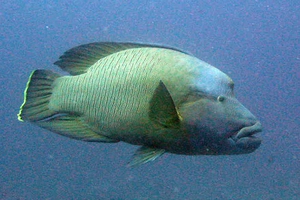Description
Also known as Blue-tooth Grouper, Double-headed Maori Wrasse, Double-headed Wrasse, Giant Humphead Wrasse, Giant Maori Wrasse, Giant Wrasse, Humpback Wrasse, Humphead, Humphead Maori Wrasse, Hump-headed Maori Wrasse, Hump-headed Wrasse, Maori Wrasse, Napoleon Maori Wrasse, Napoleonfish, Napoleon Wrasse, Tapiro Wrasse, Thicklip Wrasse, Truck Wrasse, Undulate Wrasse.
Found singly or in pairs, cruising over reefs during the day, and resting in caves and under coral ledges at night, over reef slopes, of lagoons and outer channels.
They feed on crustaceans, fish, sea hares, hard shell invertebrates, and the Crown-of-thorns Seastar.
Juveniles found in lagoons, rich in coral growth.
Length - 200cm
Depth - 1-100m
Widespread Indo-Pacific
This is the largest and most friendly of all the Wrasses, much appreciated by divers, as it is an impressively big fish that is very curious and easy to approach.
It has thick, fleshy lips and a hump that forms on its head above the eyes, becoming more prominent as the fish ages. This fish can also change sex from female to male. The factors that control the timing of sex change are not yet known.
The Humphead Wrasse is long lived, but has a very slow breeding rate. This has made it an endangered animal, as it is not being replaced fast enough to compensate for the fishing rate. Its flesh is highly demanded in eastern Asia, selling at over a hundred American dollars per kilogram.
Most reef fish seen by divers during the day, are grazers, they cruise around, just above the surface of the coral, or snoop into crevices, foraging for food.
Wrasses have small protruding teeth, which they use to graze the bottom, taking in a variety of algae, crustaceans, such as crabs, eggs, shrimps, snails and worms. Any hard coats or thick shells, are then ground down by their pharyngeal jaws, and the delicacies inside digested.
From juvenile to adult, wrasses dramatically alter their colour and body shapes.
Wrasses are always on the go during the day, but are the first to go to bed and the last to rise.
Small wrasses dive below the sand to sleep, and larger wrasses wedge themselves in crevices. Ref: http://www.fishbase.org/summary/5604























2 comments
Posted by @fishx6Yes that will be fine as long as you mention it comes from this site.
Posted by @nutraHello, I was wondering if I could use your picture for our survey (willingness to pay survey for marine conservation). If you see this message, could you please contact me at hkoike@hawaii(dot)edu? Thank you.